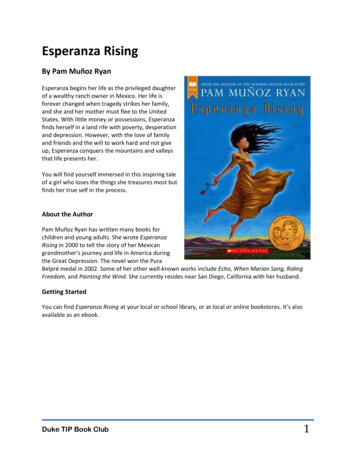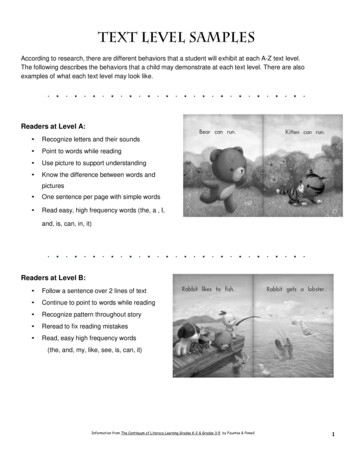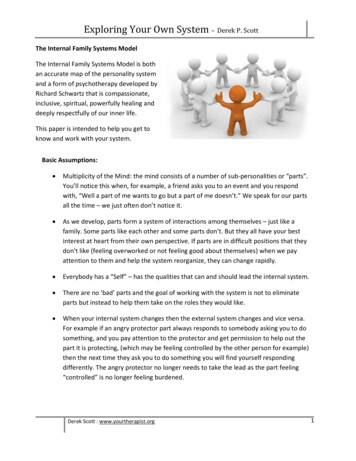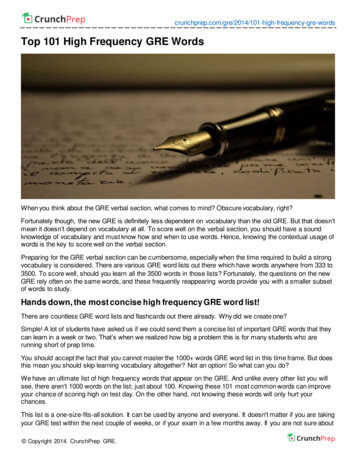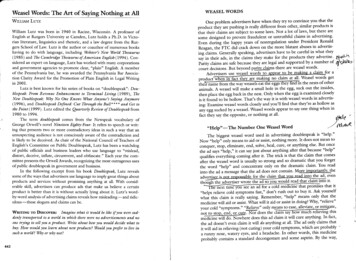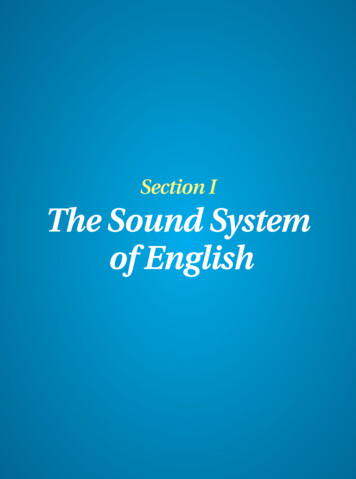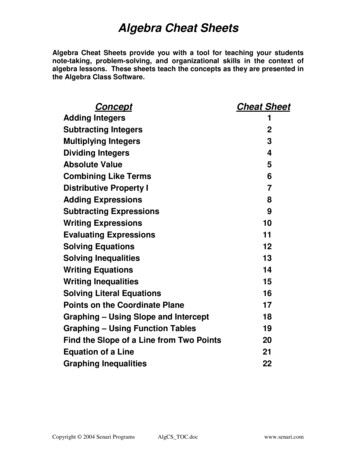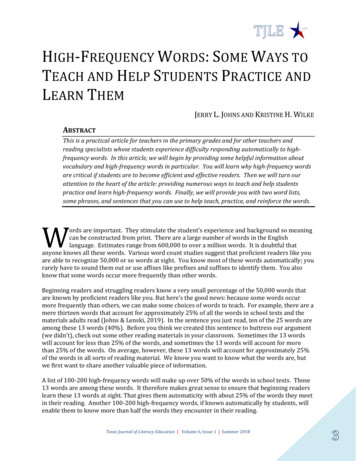
Transcription
HIGH-FREQUENCY WORDS: SOME WAYS TOTEACH AND HELP STUDENTS PRACTICE ANDLEARN THEMJERRY L. JOHNS AND KRISTINE H. WILKEABSTRACTThis is a practical article for teachers in the primary grades and for other teachers andreading specialists whose students experience difficulty responding automatically to highfrequency words. In this article, we will begin by providing some helpful information aboutvocabulary and high-frequency words in particular. You will learn why high-frequency wordsare critical if students are to become efficient and effective readers. Then we will turn ourattention to the heart of the article: providing numerous ways to teach and help studentspractice and learn high-frequency words. Finally, we will provide you with two word lists,some phrases, and sentences that you can use to help teach, practice, and reinforce the words.Words are important. They stimulate the student’s experience and background so meaningcan be constructed from print. There are a large number of words in the Englishlanguage. Estimates range from 600,000 to over a million words. It is doubtful thatanyone knows all these words. Various word count studies suggest that proficient readers like youare able to recognize 50,000 or so words at sight. You know most of these words automatically; yourarely have to sound them out or use affixes like prefixes and suffixes to identify them. You alsoknow that some words occur more frequently than other words.Beginning readers and struggling readers know a very small percentage of the 50,000 words thatare known by proficient readers like you. But here’s the good news: because some words occurmore frequently than others, we can make some choices of words to teach. For example, there are amere thirteen words that account for approximately 25% of all the words in school texts and thematerials adults read (Johns & Lenski, 2019). In the sentence you just read, ten of the 25 words areamong these 13 words (40%). Before you think we created this sentence to buttress our argument(we didn't), check out some other reading materials in your classroom. Sometimes the 13 wordswill account for less than 25% of the words, and sometimes the 13 words will account for morethan 25% of the words. On average, however, these 13 words will account for approximately 25%of the words in all sorts of reading material. We know you want to know what the words are, butwe first want to share another valuable piece of information.A list of 100-200 high-frequency words will make up over 50% of the words in school texts. Those13 words are among these words. It therefore makes great sense to ensure that beginning readerslearn these 13 words at sight. That gives them automaticity with about 25% of the words they meetin their reading. Another 100-200 high-frequency words, if known automatically by students, willenable them to know more than half the words they encounter in their reading.Texas Journal of Literacy Education Volume 6, Issue 1 Summer 2018
Here are the magic 13: a, and, for, he, in, is, it, of, that, the, to, was, you. At the end of this article, wehave included two other important word lists: Revised Dolch List (226 words) and List of HighFrequency Nouns (46 words). You may have other lists you prefer to use like the Fry list and theoriginal Dolch List. The Revised Dolch List (RDL) is statistically better than the original Dolch list,but you should feel confident with any high-frequency word list you use in your teaching andpractice activities.THE IMPORTANCE OF HIGH-FREQUENCY WORDSIf you want students to become efficient and effective readers, you need to ensure that studentsmaster these words by the end of third grade. By mastery, we mean that they recognize thesewords automatically (by sight). We recommend teaching the 13 words to mastery along withanother dozen of the most-frequently occurring words (i.e., on, as, are, they, with, be, his, at, or,from, had, I) to kindergarten students. Continue teaching more of the words from the RevisedDolch List in first and second grade and ensure mastery by third grade. For readers who struggle inthe upper grades, assess their knowledge of the high-frequency words and help students learn thewords by sight (automatically). You want all students to know the words by sight. Now, here’s thepayoff: If students are able to recognize these words by sight, they will know half or more of thewords they encounter in their reading. The words are a necessary, but insufficient condition, forefficient reading. Students will also need to learn many words beyond these couple hundred sothey can recognize most of the words in their reading. Learning several thousand more words willrequire plenty of reading in high-success texts along with systematic instruction. But students whoknow a core of 200 or so high-frequency words by sight will possess a solid foundation for reading.Now let’s focus on some of the things you can do to help your students learn high-frequency wordsso they become known at sight. We’ll begin with several teaching strategies.DIRECT TEACHING STRATEGIESEXPLICIT INSTRUCTION1. Select a high-frequency word, or several words, that students should learn to read by sight.2. Write the word(s) on the board.3. Model for the students: touch the word, say the word, and spell the word as each letteris touched.4. Have students write the word on a 4”x 6” card using assorted colored markers, pencils orcrayons.5. Have students demonstrate the procedure you modeled. Students touch the word, say the word,and spell the word touching each letter as it is said. This activity may be done independently or inpairs.6. Students may pass cards. Each time cards are passed, students touch, say, and spell each wordwhile continuing to touch each letter. Repeat.Texas Journal of Literacy Education Volume 6, Issue 1 Summer 2018
7. Use these cards during a read aloud. Every time their word is read, have students put upthe word.8. Give students a story, poem, or created passage that uses the sight word many times. Have thestudents highlight or circle the word. This text may be read to the students while they are followingalong, or they may read independently.9. Students may cut the word into letters, placing them in an envelope that has the word written onthe envelope by the student. Ask the student to build the word to practice arranging the lettersthroughout the day.10. Write many sentences with a blank space for the sight word on chart paper located around theroom. Have students write the word in the sentence, read the sentence silently, and then read thesentence aloud.LEARNING THROUGH REPETITION1. Select words from the Revised Dolch List (RDL) - perhaps the first three words from eachcolumn of the RDL (18 words). This list is at the end of the article. Ask the student to read thewords and note the words missed. If the student does not recognize the word automatically, askthem to “skip” that word and move to the next. The intent is to determine which words the studentdoes not recognize by sight.2. Create flash cards from the words that the student did not recognize by sight. You may alsoinclude the words that the student displayed hesitancy with (words may be printed on cardstockand cut out or you may write the words on index cards). As a guide, if a student recognizes a wordwithin one second or less, the student is given credit for the word. For the first session, choosethree to five words to teach.3. Present each card to the student, saying the word as it is presented and then placed in front ofthe student. Once the student recognizes the words, move them around until automaticity isachieved.4. Begin the next session by reviewing the words learned in the previous session. When the studentdemonstrates automaticity, continue with the next three to five words missed on the RDL using thesame procedure as in step three. To keep words separated, put the words that have been learnedand reviewed in the envelope with newly learned words and words missed clipped outside theenvelope.5. In each session, begin by reviewing the newly learned three to five words first, then add them tothe known words and have the student review all the words for strengthened automaticity.Unknown words are taken out each time and kept clipped on the outside of the envelope with thenewly learned words. Continue these steps until all the words are recognized automatically.6. After the student has learned the whole set, continue to review and practice the words until thestudent can automatically recognize each word three times in a row. This may be done with flashcards that the student or you can turn over once the prior word is said. Cards may be sent home forcontinued practice and review.Texas Journal of Literacy Education Volume 6, Issue 1 Summer 2018
7. Retest the student on the RDL to check for mastery. Do this by displaying the words in anotherprint form. Any words missed may be added to the new set of sight words.8. You can also create and place the words in short phrases or sentences (see phrases andsentences at the end of this article) to help promote transfer to context.SEE/HEAR/WRITE/CHANT1. Choose three to five words. Write one word on the board. Say the word as you point to theword. Have the students write the word on an index card. Then have students chant the word.2. After students chant the word, they can spell the word again as an individual or groupchant. Have fun and let the students clap or tap their foot to the spelling chant. Repeat the chantingof the word followed by the spelling of the word several times.3. Repeat steps one and two for the targeted three to five words. After all words have beenpracticed, write a word on the board and see if students can continue the chant of saying andspelling without hesitation. Repeat this process so students can begin to get a rhythm to thepractice. This activity can be done as students stand for a movement break multiple times duringthe day to practice after the initial teaching of the words (steps 1 & 2).PRACTICEResearch has found that sight word intervention games are highly effective when used for sightword achievement (Gibbon, Duffield, Hoffman, & Wageman, 2017). Below are some ideas that areeasy and fun to include for practice activities.1. Word Walls. Create word walls so students have the words always accessible. As you usethe words daily during instruction, take the time to ask them to find the word within the word walllists.Cunningham (2017) offers the following word activity suggestions: Easy Rhyming. Have students create lists of the word wall words that rhyme. Students canmake word wall booklets of these words. Easy Endings. Students can add endings such as s, ed, ing, and er to words to create morewords. Read My Mind. You or a student may choose a word on the word wall. That word can bewritten on a piece of paper without anyone seeing it. Give the students five clues to see ifthey can “read” your or the student’s mind.Example:It’s one of our Word Wall words.It has three letters.It begins with o.It is the opposite of young.It is missing from this sentence. Today I am seven years .Texas Journal of Literacy Education Volume 6, Issue 1 Summer 2018
2. Word Families. Have students create word families on chart paper. Students should say thewords after they have created the list(s) for additional practice. Some examples of word familiescan be found below.at: cat, sat, chat, mat, flat, pat, vat, bat, rat, thatad: had, sad, glad, tad, pad,an: man, can, tan, ran, fanand: hand, band, sand, land,ee: three, bee, knee, tree, see, flee, tee3. Read pattern books. Encourage students to read books to increase automaticity and buildconfidence.4. Create phrases or sentence strips that contain high-frequency words for students to practice.See example phrases and sentences at the end of this article.5. Word Search. Create your own word search using a list of high-frequency words. Depending onthe age and capability of the student, have him or her create the word search for the group. Be sureyour word searches go from left to right only. One free resource for creating word searches can befound at this -your-own/word-search/6. Sign It (Sherman, 2011). Use the following website to see what the word looks like in signlanguage: https://www.handspeak.com/word/This is a great way for students to teach others as they become familiar with the written word aswell as the word in sign language.Texas Journal of Literacy Education Volume 6, Issue 1 Summer 2018
7. Write sight words everywhere using items like those that follow. Sidewalk chalk – Take students outside and let them write around the playground. Magnets – Use magnetic letters to form words on baking sheets. If you have the opportunityto have magnetic painted walls, these are a great way to allow students to manipulateletters and form words. Sand – Pour sand in a tray and let students write the words with their finger. Play dough – Form sight words with play dough.8. Treasure Hunt. Hide high-frequency words around room. Write words on index cards, fun postits or cut outs for more fun. Have students go on a treasure hunt. The student cannot collect theword unless he or she can say the word.9. Pick a Stick. Write words on popsicle sticks or craft sticks. The words may be used in a variety ofdifferent ways. One is to call students up to pick a stick throughout the day. If they get the wordcorrect, they may win a point toward something you decide. At the end of the day or week, theymay earn extra free time or reading time!10. Memory Game. You may use the same stack of word pairs as used for Go Fish (see #12). Thecards are laid face-down on the floor. The students take turns flipping two cards over and say themas they try to remember where previously flipped words are. The student who has the mostmatches at the end wins the game.11. Sight Word Bingo, Create Bingo cards with a few sight words or sight word phrases (i.e., on thetree, in the tree). Randomly read aloud sight words, marking (or placing a small item) on eachsquare with the matching sight word.12. Go Fish. Write high-frequency words twice on index cards or cardstock and shuffle them like adeck of cards. Have a pair of students takes turns to see if another player has a sight word thatmatches one in his or her hand. If there is not a match, the student draws a card from the deck. Anypair of matching words gets stacked in a pile. After the first student has no cards, players count uptheir matches. The player with the most matches wins the game.Word Lists, Phrases, and SentencesThe four resource pages that follow can be used for both teaching and practiceactivities.Texas Journal of Literacy Education Volume 6, Issue 1 Summer 2018
Texas Journal of Literacy Education Volume 6, Issue 1 Summer 2018
Texas Journal of Literacy Education Volume 6, Issue 1 Summer 2018
Texas Journal of Literacy Education Volume 6, Issue 1 Summer 2018
Texas Journal of Literacy Education Volume 6, Issue 1 Summer 2018
REFERENCESCunningham, P. M. (2017). Phonics they use: Wordsfor reading and writing (7th ed.) (MakingWords Series). Boston, MA: Pearson.Gibbon, J. M., Duffield, S., Hoffman, J., & Wageman,J. (2017, Fall). Effects of educationalgames on sight word readingachievement and student motivation.Journal of Language and LiteracyEducation, 13(2), 1-27. Retrieved 7/11/Duffield JoLLE2017.pdfJohns, J. L., & Lenski, S. D. (2019). Improvingreading: Interventions, strategies, andCommon Core connections (7th ed.).Dubuque, IA: Kendall Hunt.Sherman, J. (2011, Summer). Signing for success:Using American sign language to learnsight vocabulary. SRATE Journal, 20(2),31-39. Retrieved lltext/EJ959527.pdWord Search Maker Highly Customizable Freeand NO Registration Required! (n.d.).Retrieved your-own/word-search/AUTHORSJerry L. Johns, Distinguished Teaching Professor Emeritus, Northern Illinois University; email:jjohns@niu.eduKristine Wilke, ASSIST & Outreach Coordinator, Jerry L. Johns Literacy Clinic; email:kwilke1@niu.eduTexas Journal of Literacy Education Volume 6, Issue 1 Summer 2018
print form. Any words missed may be added to the new set of sight words. 8. You can also create and place the words in short phrases or sentences (see phrases and sentences at the end of this article) to help promote transfer to context. SEE/HEAR/WRITE/CHANT 1. Choose three to five words. W

